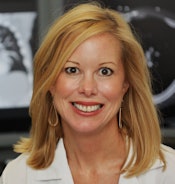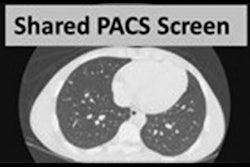
Radiologists are being told they need to spend more time with patients, but is this a realistic expectation? A new survey published June 20 in Radiology found that while most radiologists would like more patient-facing time, the realities of their jobs -- such as reimbursement for their time -- get in the way.
Radiologists generally agree with statements saying that radiology's role in patient care should be promoted, and that radiologists should be available to patients, according to the study led by Dr. Jennifer Kemp of Diversified Radiology of Colorado (Radiology, June 20, 2017). But radiologists aren't paid for these activities, creating financial tension between what radiologists are being told they should do and what they actually need to do to pay the bills.
 Dr. Jennifer Kemp from Diversified Radiology of Colorado.
Dr. Jennifer Kemp from Diversified Radiology of Colorado.Until this tension is resolved, it's going to be challenging to shift radiologists to engaging more with patients.
"Our survey results suggest that a disconnect exists between what radiology leadership has espoused and how many, if not most, radiologists currently practice," the researchers noted.
Shifting the discipline
For at least a decade, organized radiology has recognized the need to shift the discipline toward patient-centered care. The focus has gained momentum with recent efforts at the federal level to move the U.S. healthcare system from reimbursement based on volume to a system oriented toward value. Recent studies even indicate that patients themselves would welcome more contact with radiologists.
The RSNA in 2011 formed a Patient-Centered Radiology Steering Committee to develop awareness for patient-centered radiology. In 2015, the committee decided to survey RSNA members about their attitudes and experiences regarding the topic.
Kemp and colleagues drafted a survey with questions on patient-centered radiology that was sent to a random sample of 5,890 RSNA members. In all, 694 responses were received, for a response rate of 12%. Responses came from a variety of geographic locations and age groups, with 59% coming from radiologists in academic settings and 41% from those in private practice.
Respondents generally agreed that radiology's awareness should be promoted to patients, but the rate of agreement declined for activities that took up more of their personal time.
| Radiologist agreement with importance of patient-centered activities | |
| Type of activity | Percent agreement |
| Promote awareness of radiology's role in overall care of patients | 89% |
| Be available to patients for questions immediately after procedures or exams | 71% |
| Convey imaging results to patients in person | 41% |
| Interact with patients using social media | 32% |
The group also found that academic radiologists tended to have higher levels of agreement than those in private practice on statements indicating they should engage in specific activities to improve patient engagement.
| Radiologist agreement with patient engagement, private practice vs. academic | ||
| Type of activity | Private-practice radiologist | Academic radiologist |
| Communicate with patients before exam or procedure | 51% | 69% |
| Convey imaging results in person | 36% | 46% |
| Be available to patients after exams | 63% | 76% |
| Interact with patients using social media and other tools | 28% | 37% |
The researchers also analyzed survey responses from radiology subspecialties with higher levels of patient engagement, such as mammography, interventional radiology, pediatric radiology, and radiation oncology, and compared them with areas that didn't typically engage with patients (basically, all other areas of radiology).
Perhaps unsurprisingly, the more patient-facing disciplines tended to support higher levels of patient engagement than those with less patient time. For example, 76% of the patient-facing radiology subspecialties agreed that it was important for practices to communicate with patients before exams, compared with 55% for the less engaged disciplines.
Barriers to patient communication
So if most radiologists agree that they should be communicating with patients, then why aren't they doing it more often? The survey also included this question, with 73% of respondents stating that time or workload was the biggest barrier, while 35% mentioned resistance from the patient's referring provider. When broken down further by subspecialty type, radiology disciplines with less patient interaction reported higher levels for every type of barrier.
| Barriers to direct patient communication by radiology subspecialty type | ||
| Type of activity | Subspecialty with less patient interaction | Subspecialty with more patient interaction |
| Time or workload | 80% | 60% |
| Referring physician preference | 40% | 25% |
| Resistance to culture change | 35% | 22% |
| Administration rules | 25% | 14% |
In search of a solution
So what's the best way to break down barriers to patient communication? Kemp and colleagues found their answer in the comments section of the survey, where respondents stated that reimbursement and compensation concerns were at the top of the list. The researchers speculated that radiologists are working so hard to maintain their incomes that they are hindering job satisfaction, which could lead to negative effects on the well-being of both patients and radiologists.
One possible solution is to reimburse radiologists for their time spent consulting with patients. However, the problem is that radiology practices might respond to these lower workloads by hiring more radiologists, reducing revenue per capita.
"Thus, there is a fundamental economic dynamic functioning here that cannot be dismissed, and it points to a fundamental tension currently at play within radiology," they wrote.
They go on to suggest that efforts to get radiologists to interact more with patients might be more effective if they include "demonstrably enhanced reimbursement for the noninterpretive time." Other intriguing options include integrating reading rooms into subspecialty clinics, as well as utilizing social media platforms, which can provide a channel for radiologist-patient communication without compromising productivity and revenue, the researchers noted.
But in the end, it could be a case of short-term pain for long-term gain.
"Our radiology culture may need to adapt to decreased income to accomplish more ideal patient-centered care," they concluded. "Ultimately, radiologists might find themselves more satisfied for having done so. Regardless, if this change is not internally motivated, external forces may impose it as the healthcare system evolves."



















